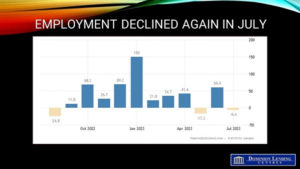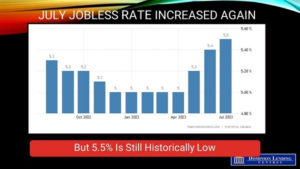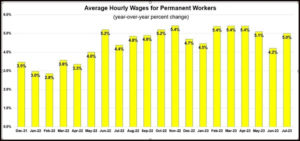The long-awaited labour market slowdown
The Canadian economy shed 6,400 jobs in July, far weaker than the 25,000 gain that was expected. The jobless rate was 5.5%, the third consecutive monthly rise. This likely improves the chances the Bank of Canada will remain on the sidelines in September.
Wage inflation, however, re-accelerated, moving back to 5.0%. This, combined with the continued stickiness in core inflation, will keep interest rates high for longer.
July’s data follows a surprise gain of 59,900 in June and a 17,300 loss in May, showing that employment is a notoriously volatile series. Nevertheless, it provides the fodder for Macklem to pause again after two consecutive rate hikes.

A downturn in June’s manufacturing, wholesale, and retail data has buoyed the Bank’s hopes that the 475 basis point rate hikes have slowed the economy, especially as preliminary figures for June showed the economy contracting for the first time this year. Inflation rates for the same month moderated to 2.8%, fitting within the central bank’s target range for the first time since March 2021.

Policymakers scrutinize indicators to determine if the current interest rates are sufficiently high to temper economic growth. They perceive substantial wage increases as inconsistent with their goal of reducing inflation to the 2% target. Even amidst recent significant strikes from workers demanding improved remuneration, the outlook hints at a potential slowdown in wage growth. This could be driven by increased immigration, which expands the workforce while the demand for labour diminishes.

Bottom Line
The chances of a rate hike on September 6 have diminished significantly. However, more data is yet to come with July inflation on August 15 and the Q2 GDP figure on September 1.
Please Note: The source of this article is from SherryCooper.com/category/articles/